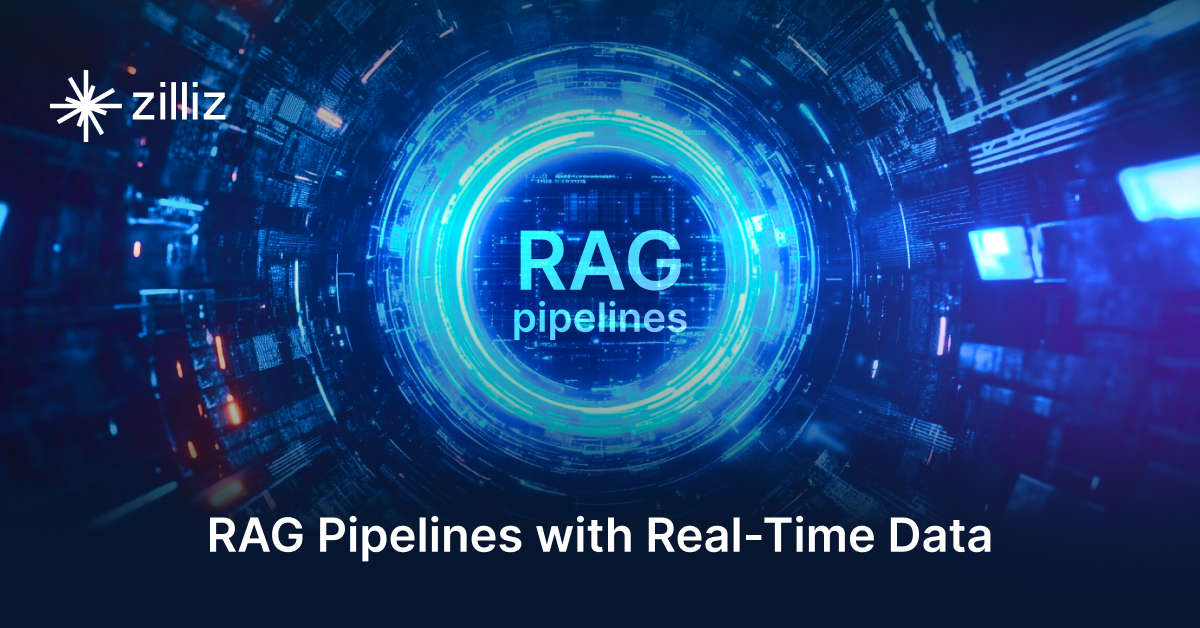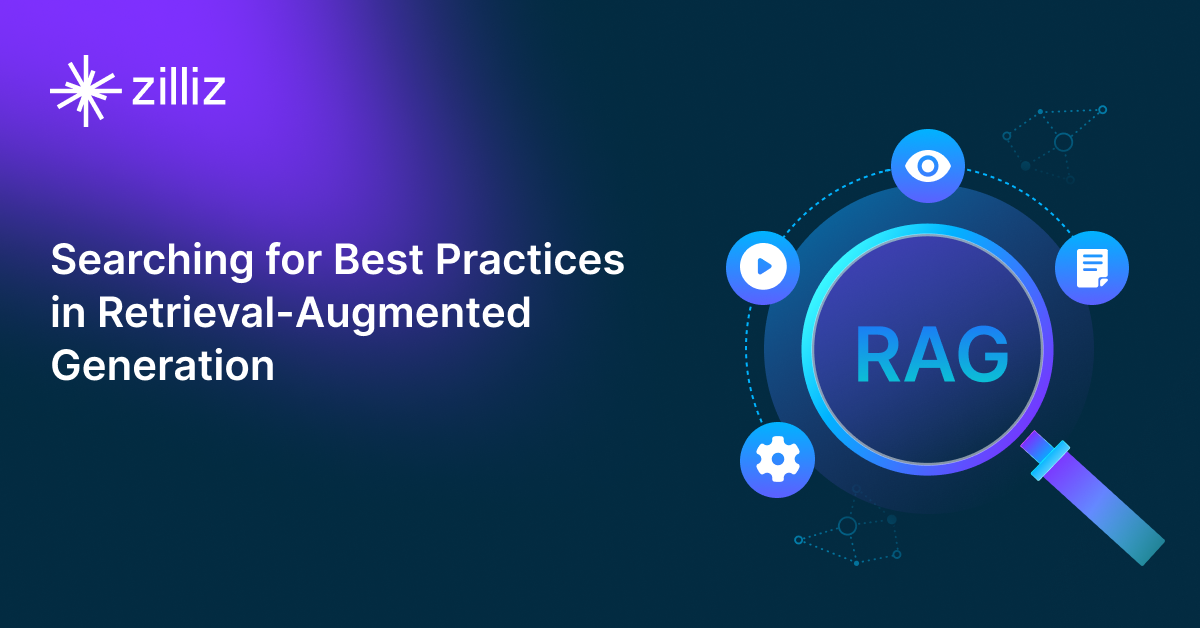Build RAG Chatbot with Haystack, Milvus, STACKIT Meta-Llama-3.1-70B-Instruct-FP8, and Cohere embed-english-light-v2.0
Introduction to RAG
Retrieval-Augmented Generation (RAG) is a game-changer for GenAI applications, especially in conversational AI. It combines the power of pre-trained large language models (LLMs) like OpenAI’s GPT with external knowledge sources stored in vector databases such as Milvus and Zilliz Cloud, allowing for more accurate, contextually relevant, and up-to-date response generation. A RAG pipeline usually consists of four basic components: a vector database, an embedding model, an LLM, and a framework.
Key Components We'll Use for This RAG Chatbot
This tutorial shows you how to build a simple RAG chatbot in Python using the following components:
- Haystack: An open-source Python framework designed for building production-ready NLP applications, particularly question answering and semantic search systems. Haystack excels at retrieving information from large document collections through its modular architecture that combines retrieval and reader components. Ideal for developers creating search applications, chatbots, and knowledge management systems that require efficient document processing and accurate information extraction from unstructured text.
- Milvus: An open-source vector database optimized to store, index, and search large-scale vector embeddings efficiently, perfect for use cases like RAG, semantic search, and recommender systems. If you hate to manage your own infrastructure, we recommend using Zilliz Cloud, which is a fully managed vector database service built on Milvus and offers a free tier supporting up to 1 million vectors.
- STACKIT Meta-Llama-3.1-70B-Instruct-FP8: A 70-billion-parameter instruction-tuned AI model optimized for complex NLP tasks. Leveraging FP8 quantization, it balances high performance with efficient resource usage, excelling in understanding nuanced instructions and generating context-aware responses. Ideal for enterprise applications requiring precise, scalable solutions in chatbots, virtual assistants, data analysis, and automated content generation.
- Cohere embed-english-light-v2.0: A lightweight embedding model optimized to convert English text into dense vector representations efficiently. It excels in semantic search, clustering, and similarity tasks, balancing speed and accuracy. Ideal for real-time applications, cost-sensitive deployments, and resource-constrained environments requiring scalable, rapid text analysis without compromising performance.
By the end of this tutorial, you’ll have a functional chatbot capable of answering questions based on a custom knowledge base.
Note: Since we may use proprietary models in our tutorials, make sure you have the required API key beforehand.
Step 1: Install and Set Up Haystack
import os
import requests
from haystack import Pipeline
from haystack.components.converters import MarkdownToDocument
from haystack.components.preprocessors import DocumentSplitter
from haystack.components.writers import DocumentWriter
Step 2: Install and Set Up STACKIT Meta-Llama-3.1-70B-Instruct-FP8
STACKIT is the cloud and colocation provider of the Schwarz Group. We can use different models on its cloud services with ease through its API.
pip install stackit-haystack
from haystack_integrations.components.generators.stackit import STACKITChatGenerator
from haystack.dataclasses import ChatMessage
generator = STACKITChatGenerator(model="neuralmagic/Meta-Llama-3.1-70B-Instruct-FP8")
Step 3: Install and Set Up Cohere embed-english-light-v2.0
To start using this integration with Haystack, install it with:
pip install cohere-haystack
from haystack import Document
from haystack_integrations.components.embedders.cohere.document_embedder import CohereDocumentEmbedder
from haystack_integrations.components.embedders.cohere.text_embedder import CohereTextEmbedder
text_embedder = CohereTextEmbedder(model="embed-english-light-v2.0")
document_embedder = CohereDocumentEmbedder(model="embed-english-light-v2.0")
Step 4: Install and Set Up Milvus
pip install --upgrade pymilvus milvus-haystack
from milvus_haystack import MilvusDocumentStore
from milvus_haystack.milvus_embedding_retriever import MilvusEmbeddingRetriever
document_store = MilvusDocumentStore(connection_args={"uri": "./milvus.db"}, drop_old=True,)
retriever = MilvusEmbeddingRetriever(document_store=document_store, top_k=3)
Step 5: Build a RAG Chatbot
Now that you’ve set up all components, let’s start to build a simple chatbot. We’ll use the Milvus introduction doc as a private knowledge base. You can replace it your own dataset to customize your RAG chatbot.
url = 'https://raw.githubusercontent.com/milvus-io/milvus-docs/refs/heads/v2.5.x/site/en/about/overview.md'
example_file = 'example_file.md'
response = requests.get(url)
with open(example_file, 'wb') as f:
f.write(response.content)
file_paths = [example_file] # You can replace it with your own file paths.
indexing_pipeline = Pipeline()
indexing_pipeline.add_component("converter", MarkdownToDocument())
indexing_pipeline.add_component("splitter", DocumentSplitter(split_by="sentence", split_length=2))
indexing_pipeline.add_component("embedder", document_embedder)
indexing_pipeline.add_component("writer", DocumentWriter(document_store))
indexing_pipeline.connect("converter", "splitter")
indexing_pipeline.connect("splitter", "embedder")
indexing_pipeline.connect("embedder", "writer")
indexing_pipeline.run({"converter": {"sources": file_paths}})
# print("Number of documents:", document_store.count_documents())
question = "What is Milvus?" # You can replace it with your own question.
retrieval_pipeline = Pipeline()
retrieval_pipeline.add_component("embedder", text_embedder)
retrieval_pipeline.add_component("retriever", retriever)
retrieval_pipeline.connect("embedder", "retriever")
retrieval_results = retrieval_pipeline.run({"embedder": {"text": question}})
# for doc in retrieval_results["retriever"]["documents"]:
# print(doc.content)
# print("-" * 10)
from haystack.utils import Secret
from haystack.components.builders import PromptBuilder
retriever = MilvusEmbeddingRetriever(document_store=document_store, top_k=3)
text_embedder = CohereTextEmbedder(model="embed-english-light-v2.0")
prompt_template = """Answer the following query based on the provided context. If the context does
not include an answer, reply with 'I don't know'.\n
Query: {{query}}
Documents:
{% for doc in documents %}
{{ doc.content }}
{% endfor %}
Answer:
"""
rag_pipeline = Pipeline()
rag_pipeline.add_component("text_embedder", text_embedder)
rag_pipeline.add_component("retriever", retriever)
rag_pipeline.add_component("prompt_builder", PromptBuilder(template=prompt_template))
rag_pipeline.add_component("generator", generator)
rag_pipeline.connect("text_embedder.embedding", "retriever.query_embedding")
rag_pipeline.connect("retriever.documents", "prompt_builder.documents")
rag_pipeline.connect("prompt_builder", "generator")
results = rag_pipeline.run({"text_embedder": {"text": question}, "prompt_builder": {"query": question},})
print('RAG answer:\n', results["generator"]["replies"][0])
Optimization Tips
As you build your RAG system, optimization is key to ensuring peak performance and efficiency. While setting up the components is an essential first step, fine-tuning each one will help you create a solution that works even better and scales seamlessly. In this section, we’ll share some practical tips for optimizing all these components, giving you the edge to build smarter, faster, and more responsive RAG applications.
Haystack optimization tips
To optimize Haystack in a RAG setup, ensure you use an efficient retriever like FAISS or Milvus for scalable and fast similarity searches. Fine-tune your document store settings, such as indexing strategies and storage backends, to balance speed and accuracy. Use batch processing for embedding generation to reduce latency and optimize API calls. Leverage Haystack's pipeline caching to avoid redundant computations, especially for frequently queried documents. Tune your reader model by selecting a lightweight yet accurate transformer-based model like DistilBERT to speed up response times. Implement query rewriting or filtering techniques to enhance retrieval quality, ensuring the most relevant documents are retrieved for generation. Finally, monitor system performance with Haystack’s built-in evaluation tools to iteratively refine your setup based on real-world query performance.
Milvus optimization tips
Milvus serves as a highly efficient vector database, critical for retrieval tasks in a RAG system. To optimize its performance, ensure that indexes are properly built to balance speed and accuracy; consider utilizing HNSW (Hierarchical Navigable Small World) for efficient nearest neighbor search where response time is crucial. Partitioning data based on usage patterns can enhance query performance and reduce load times, enabling better scalability. Regularly monitor and adjust cache settings based on query frequency to avoid latency during data retrieval. Employ batch processing for vector insertions, which can minimize database lock contention and enhance overall throughput. Additionally, fine-tune the model parameters by experimenting with the dimensionality of the vectors; higher dimensions can improve retrieval accuracy but may increase search time, necessitating a balance tailored to your specific use case and hardware infrastructure.
STACKIT Meta-Llama-3.1-70B-Instruct-FP8 optimization tips
To optimize STACKIT Meta-Llama-3.1-70B-Instruct-FP8 in RAG, prioritize reducing input token length by truncating or summarizing retrieved documents to fit the model’s context window. Use FP8 precision to accelerate inference while maintaining accuracy. Batch processing for parallel queries improves throughput. Cache frequent or repetitive queries to avoid redundant computations. Fine-tune retrieval thresholds to balance relevance and noise. Leverage hardware-specific optimizations (e.g., Tensor Cores on GPUs) and enable model parallelism for distributed workloads. Monitor memory usage to prevent bottlenecks, and prune low-confidence outputs early to save resources.
Cohere embed-english-light-v2.0 optimization tips
To optimize Cohere embed-english-light-v2.0 in RAG, preprocess input text by truncating or chunking documents to the model’s 512-token limit for efficiency. Use batch processing to encode multiple texts simultaneously, reducing API overhead. Normalize embeddings to improve cosine similarity accuracy. Pair with a fast vector database (e.g., FAISS) for low-latency retrieval. Cache frequent queries to minimize redundant computations. Monitor embedding quality via retrieval hit rates and adjust text chunking strategies for domain-specific contexts. Fine-tune batch sizes to balance speed and memory usage.
By implementing these tips across your components, you'll be able to enhance the performance and functionality of your RAG system, ensuring it’s optimized for both speed and accuracy. Keep testing, iterating, and refining your setup to stay ahead in the ever-evolving world of AI development.
RAG Cost Calculator: A Free Tool to Calculate Your Cost in Seconds
Estimating the cost of a Retrieval-Augmented Generation (RAG) pipeline involves analyzing expenses across vector storage, compute resources, and API usage. Key cost drivers include vector database queries, embedding generation, and LLM inference.
RAG Cost Calculator is a free tool that quickly estimates the cost of building a RAG pipeline, including chunking, embedding, vector storage/search, and LLM generation. It also helps you identify cost-saving opportunities and achieve up to 10x cost reduction on vector databases with the serverless option.
 Calculate your RAG cost
Calculate your RAG cost
What Have You Learned?
By diving into this tutorial, you’ve unlocked the magic of building a RAG system from the ground up, weaving together cutting-edge tools to create something truly powerful! You discovered how Haystack acts as the backbone, seamlessly orchestrating your pipeline by connecting the dots between components. With Milvus as your vector database, you learned to store and retrieve dense embeddings at lightning speed, ensuring your system can handle complex queries without breaking a sweat. The Cohere embed-english-light-v2.0 model became your trusty sidekick, transforming text into rich numerical representations that capture meaning and context, while the STACKIT Meta-Llama-3-70B-Instruct-FP8 model blew you away with its ability to generate human-like, nuanced answers by synthesizing retrieved data. Together, these pieces form a symphony of efficiency and intelligence, letting you build applications that don’t just answer questions—they understand them. Along the way, you picked up pro tips like optimizing chunk sizes for faster retrieval and leveraging FP8 precision to slash computational costs without sacrificing performance. And let’s not forget the free RAG cost calculator you explored—your new secret weapon for budgeting and scaling projects smartly!
Now, imagine what’s next! You’ve got the blueprint to create AI that feels almost alive, capable of tackling everything from customer support to research. The tools are in your hands, the concepts are crystal clear, and the possibilities? Endless. Whether you’re refining your pipeline’s speed, experimenting with hybrid search strategies, or dreaming up entirely new use cases, this is your moment to innovate. So fire up your IDE, tweak those parameters, and let your creativity run wild. The world needs smarter AI—and you’re the one who’s going to build it. Let’s go make magic happen! 🚀
Further Resources
🌟 In addition to this RAG tutorial, unleash your full potential with these incredible resources to level up your RAG skills.
- How to Build a Multimodal RAG | Documentation
- How to Enhance the Performance of Your RAG Pipeline
- Graph RAG with Milvus | Documentation
- How to Evaluate RAG Applications - Zilliz Learn
- Generative AI Resource Hub | Zilliz
We'd Love to Hear What You Think!
We’d love to hear your thoughts! 🌟 Leave your questions or comments below or join our vibrant Milvus Discord community to share your experiences, ask questions, or connect with thousands of AI enthusiasts. Your journey matters to us!
If you like this tutorial, show your support by giving our Milvus GitHub repo a star ⭐—it means the world to us and inspires us to keep creating! 💖
- Introduction to RAG
- Key Components We'll Use for This RAG Chatbot
- Step 1: Install and Set Up Haystack
- Step 2: Install and Set Up STACKIT Meta-Llama-3.1-70B-Instruct-FP8
- Step 3: Install and Set Up Cohere embed-english-light-v2.0
- Step 4: Install and Set Up Milvus
- Step 5: Build a RAG Chatbot
- Optimization Tips
- RAG Cost Calculator: A Free Tool to Calculate Your Cost in Seconds
- What Have You Learned?
- Further Resources
- We'd Love to Hear What You Think!
Content
Vector Database at Scale
Zilliz Cloud is a fully-managed vector database built for scale, perfect for your RAG apps.
Try Zilliz Cloud for Free


